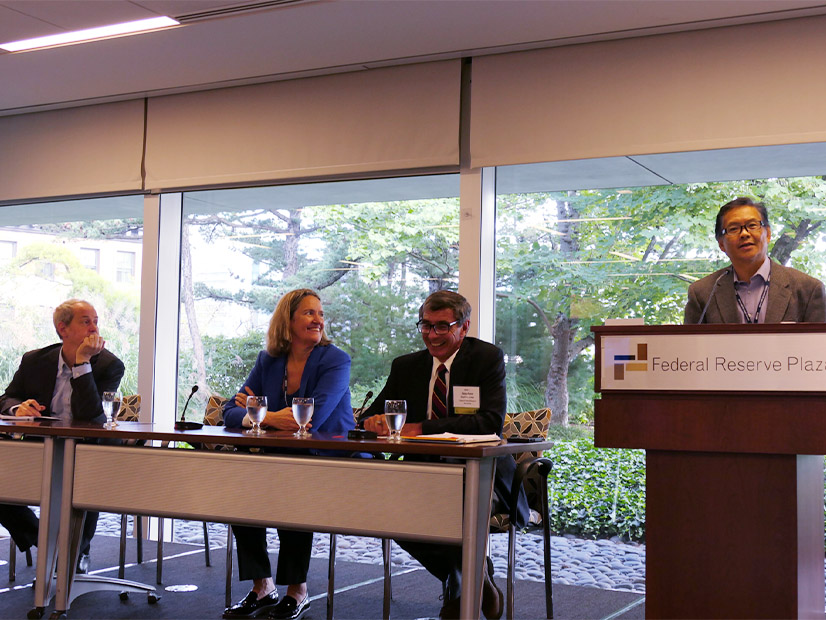BOSTON — In a reflection of broader disagreements across the New England energy landscape, speakers at the Northeast Energy and Commerce Association’s 2024 Fuels Conference presented divergent visions of the role of natural gas in coming decades.
New England states face significant pipeline constraints limiting the amount of gas that can be transported into the region. That has spurred expensive long-term contracts to secure LNG supply to support the reliability of the gas system during period of peak demand. (See Massachusetts DPU Approves Everett LNG Contracts.)
Gas demand for electricity generation and for residential, commercial and industrial needs has risen in recent years. That has led the gas industry and some large consumers to call for increased pipeline capacity.
Matthew Piatek of S&P Global said that though annual gas demand in the Northeast is projected to decline slightly by the end of the decade, peak demand will remain high.
“The price swings that we see moving forward may be more severe than they have been in the past,” Piatek said. Producers likely will be cautious about increasing supply going forward, and he said to “expect some price repercussions before there’s a supply response.”
New England’s reliance on LNG likely will continue over the medium term to meet peak demand, Piatek said, but a pipeline expansion could reduce LNG reliance.
While aggressive deployment of demand-side measures and pilot projects for technologies like networked ground-source heat pumps also could help ease peak demand pressures, “more work needs to be done on the actual commercial viability of different options,” Piatek said.
Doubling down on natural gas likely would run contrary to state climate mandates. Massachusetts has aggressive sector-specific decarbonization requirements, and natural gas is the main source of emissions from the state’s power and building sectors. Methane leaks — which typically are undercounted in emissions inventories — have a far greater short-term warming effect on the climate than carbon dioxide.
Conflicts over the future of gas have caused notable tensions among top Massachusetts lawmakers. While the Massachusetts Department of Public Utilities (DPU) has ruled that decarbonization of the state’s gas network likely will be based on electrification, the DPU also has indicated legislative changes are needed to initiate decommissioning of parts of the gas network (DPU 20-80).
Disagreement over potential legislative changes helped derail negotiations on a wide-ranging climate bill this summer. (See Mass. Lawmakers Fail to Pass Permitting, Gas Utility Reform.) The debate also has played out in other states across the region; both Maine and Rhode Island have ongoing studies into the future of natural gas.
Marc Brown of the Consumer Energy Alliance, which represents a wide range of industrial energy consumers including major fossil fuel companies, argued that natural gas “is going to play a very important role in balancing out this energy transition.”
“I don’t see gas as a transitional fuel, I see it as here for the long term,” Brown added.
Regarding concerns that new investments in natural gas infrastructure could lead to burdensome stranded costs, Brown said “nobody likes stranded costs, but we should also be concerned about upfront costs” associated with widescale electrification.

Anastasia Daou, of commercial real estate association NAIOP, echoed Brown’s concerns about upfront costs and said Massachusetts building energy codes finalized in 2023 will increase the cost of new building development.
“The building sector is feeling a little targeted recently,” Daou said, noting that adding costs to new building projects “is simply going to stop development.”
Government representatives from Maine and Massachusetts pushed back on the narrative that the states are moving too quickly away from gas.
“We’re clearly headed toward a future where we are less reliant on natural gas,” said Melissa Lavinson, executive director of Massachusetts’ newly created Office of Energy Transformation. Lavinson emphasized that the state has legislatively mandated emissions limits and that the DPU has directed the state’s electric distribution utilities to pursue “basically an electrification pathway” for decarbonization.
Maine Public Advocate William Harwood said, “the public expects us to meet those greenhouse gas emission goals,” and it’s the job of lawmakers to cut emissions while keeping energy costs as low as possible, protecting low-income customers and keeping businesses afloat.
“You don’t have to be paying particularly close attention to understand that there are very serious environmental consequences — along with public health consequences — associated with burning gas within homes,” Harwood said.
Harwood said states must look ahead when considering new gas investments to minimize stranded costs and must be honest about who will pay for stranded costs when they occur.
“When we get to that point, there is going to be a huge fight over whether those costs are the responsibility of ratepayers or shareholders,” Harwood said. “I don’t know that there’s a good solution for who pays for stranded costs.”
Low Carbon Fuel Standards
Also at the conference, several speakers made the case for low carbon fuel standard (LCFS) programs to cut transportation emissions. LCFS policies typically incentivize low-carbon fuels through charges imposed on carbon-intensive fuels.
LCFS programs targeting transportation emissions have been rolled out in California, Washington and Oregon but have yet to gain significant traction on the East Coast.
Rich Kassel, a partner at consulting firm AJW, said an LCFS is “the only program in the transportation sector on the large scale that addresses emissions from existing vehicles.”
LCFS programs in the West have reduced emissions of local pollutants and particulates due to the cleaner-burning properties of renewable diesel and biodiesel, Kassel said.
Kassel added that the greatest pollution reductions have occurred in environmental justice neighborhoods and that the equity benefits could be even greater if a small percentage of revenue generated by the program were required to be spent in environmental justice communities.
“It’s the way you get Exxon to buy electric school buses in West Harlem,” Kassel said.